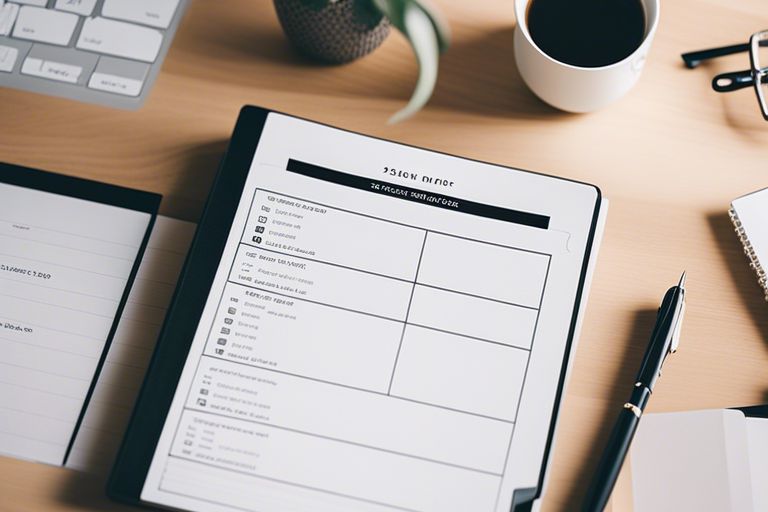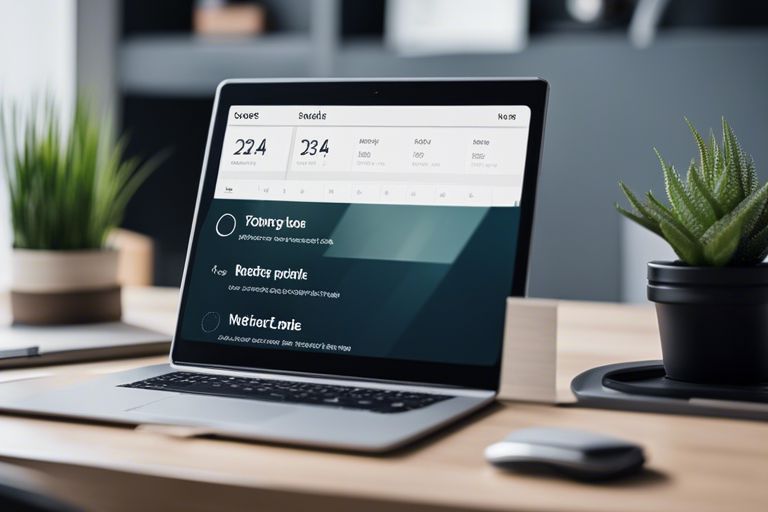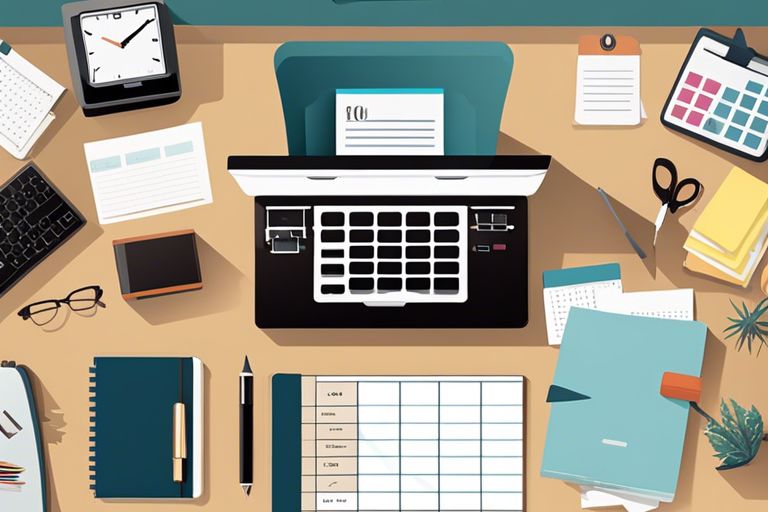The Importance of Effective Task Management
Efficient task management is crucial for individuals seeking to improve their productivity and organization skills. By effectively managing tasks, one can maximize their time, accomplish goals, and maintain a sense of control over their workload. Let’s explore why effective task management is crucial and the benefits it brings.
Why Effective Task Management is Crucial
Effective task management is essential for several reasons. Firstly, it helps individuals stay organized and focused, enabling them to prioritize tasks and allocate their time and resources efficiently. By having a clear understanding of what needs to be done and when, individuals can minimize stress and avoid last-minute rushes.
Secondly, effective task management enhances productivity. When tasks are well-structured and managed, individuals can work systematically and avoid becoming overwhelmed by a chaotic workload. By breaking down tasks into manageable steps and setting realistic deadlines, one can maintain a steady workflow and achieve better results.
Finally, effective task management promotes accountability and responsibility. By keeping track of tasks and deadlines, individuals are more likely to complete their work on time and take ownership of their responsibilities. This not only enhances personal productivity but also contributes to a positive work culture, where everyone can rely on each other to fulfill their obligations.
Benefits of Improved Productivity and Organization
Improving productivity and organization through effective task management brings numerous benefits. Here are some key advantages:
| Benefits |
|---|
| Enhanced Time Management: Effective task management allows individuals to make the most of their time, ensuring that important tasks are prioritized and completed efficiently. |
| Reduced Stress: By having a clear plan and structure in place, individuals can reduce stress and anxiety associated with overwhelming workloads. |
| Improved Focus and Concentration: Task management techniques help individuals stay focused on one task at a time, minimizing distractions and promoting deep concentration. |
| Increased Efficiency: Well-managed tasks lead to increased efficiency, as individuals can identify and eliminate unnecessary steps or inefficiencies in their workflow. |
| Greater Satisfaction and Accomplishment: Successfully completing tasks on time and achieving goals provides a sense of satisfaction and accomplishment, boosting self-confidence and motivation. |
| Better Work-Life Balance: Effective task management helps individuals prioritize tasks and allocate time for personal activities, leading to a healthier work-life balance. |
By implementing effective task management techniques, individuals can experience these benefits and improve their overall productivity and organization. Whether it’s utilizing task management software, task management apps, or other task management tools, finding the right approach can greatly enhance task management capabilities.
In the next sections, we will explore various task management techniques, prioritize and plan tasks effectively, schedule tasks using time blocking, and learn how to manage distractions and procrastination. Stay tuned to uncover the strategies that will help you master productivity and accomplish tasks with ease.
Task Management Techniques
When it comes to effective task management, utilizing proven techniques can greatly enhance productivity and organization. In this section, we will explore three popular task management techniques: the Pomodoro Technique, the Eisenhower Matrix, and the GTD (Getting Things Done) Method.
The Pomodoro Technique
The Pomodoro Technique is a time management method developed by Francesco Cirillo. It revolves around the concept of working in focused intervals, known as “Pomodoros,” followed by short breaks. Here’s how it works:
- Choose a task you want to accomplish.
- Set a timer for 25 minutes, known as one Pomodoro.
- Work on the task with full focus and commitment until the timer goes off.
- Take a short break of around 5 minutes.
- Repeat the process, completing four Pomodoros.
- After completing four Pomodoros, take a longer break of around 15-30 minutes.
The Pomodoro Technique helps individuals maintain focus by breaking tasks into manageable chunks and providing dedicated time for rest and rejuvenation. It can be particularly effective for individuals struggling with distractions and procrastination.
The Eisenhower Matrix
The Eisenhower Matrix, also known as the Urgent-Important Matrix, is a powerful tool for prioritizing tasks based on their urgency and importance. It helps individuals focus on tasks that truly matter and avoid wasting time on unimportant activities. The matrix consists of four quadrants:
| Quadrant | Description |
|---|---|
| Quadrant 1 (Urgent and Important) | Tasks that are both urgent and important. These tasks should be prioritized and completed as soon as possible. |
| Quadrant 2 (Important but Not Urgent) | Tasks that are important but not time-sensitive. These tasks should be scheduled and given proper attention to prevent them from becoming urgent. |
| Quadrant 3 (Urgent but Not Important) | Tasks that are urgent but not necessarily important. These tasks should be delegated or minimized to free up time for more important activities. |
| Quadrant 4 (Not Urgent and Not Important) | Tasks that are neither urgent nor important. These tasks should be eliminated or minimized as they provide little value and can be distractions. |
By categorizing tasks into these quadrants, individuals can make informed decisions about how to allocate their time and energy effectively.
The GTD (Getting Things Done) Method
The GTD (Getting Things Done) Method, developed by David Allen, is a comprehensive approach to task management and productivity. It emphasizes capturing, organizing, and reviewing tasks to maintain clarity and control. The key principles of the GTD Method include:
- Capture: Collect all tasks, ideas, and commitments in a trusted system.
- Clarify: Process each item to determine its significance and next actions.
- Organize: Categorize tasks into specific lists (e.g., next actions, projects, waiting, someday/maybe).
- Reflect: Regularly review and update task lists to ensure they align with goals and priorities.
- Engage: Take action on tasks based on priority, context, and availability.
The GTD Method provides individuals with a structured framework for managing tasks, reducing overwhelm, and increasing productivity.
By incorporating these task management techniques into your routine, you can enhance your productivity, effectively prioritize tasks, and maintain better control over your workload. Explore different methods and find the ones that work best for you. Remember, task management is a continuous process that requires regular review and adjustment to ensure optimal efficiency and organization.
Prioritizing and Planning
To effectively manage tasks, prioritization and planning are essential. By setting clear goals and objectives, breaking down tasks, and creating a task hierarchy, individuals can improve their productivity and ensure that the most important tasks are completed in a timely manner.
Setting Clear Goals and Objectives
Before diving into task management, it’s crucial to establish clear goals and objectives. Clearly defining what needs to be accomplished allows individuals to align their tasks with the bigger picture. Whether it’s a short-term project or a long-term goal, having a clear direction helps to prioritize tasks effectively.
When setting goals and objectives, it’s important to make them specific, measurable, achievable, relevant, and time-bound (SMART). This framework ensures that goals are well-defined and actionable. By having SMART goals, individuals can focus their efforts on the tasks that contribute most to their desired outcomes.
Breaking Down Tasks
Once goals and objectives are established, it’s time to break them down into smaller, more manageable tasks. Breaking down tasks helps to avoid overwhelm and provides a clear roadmap for accomplishing the larger goal.
When breaking down tasks, consider dividing them into smaller, actionable steps. This allows for a more focused approach and provides a sense of progress as each task is completed. Breaking down tasks also helps to identify any dependencies or prerequisites, ensuring that tasks can be executed in the most efficient order.
Creating a Task Hierarchy
Creating a task hierarchy involves organizing tasks based on their priority and interdependencies. This allows individuals to understand which tasks should be completed first and which tasks are dependent on others.
One effective approach to creating a task hierarchy is using the ABC method, where tasks are categorized as A (high priority), B (medium priority), or C (low priority). This categorization helps individuals allocate their time and resources accordingly, ensuring that the most critical tasks are addressed first.
Another useful technique is using a task matrix, such as the Urgent-Important Matrix or the Eisenhower Matrix. These matrices help individuals assess tasks based on their urgency and importance, allowing for better prioritization and decision-making.
By prioritizing and planning tasks through goal setting, task breakdown, and task hierarchy creation, individuals can approach their work in a more organized and efficient manner. This not only improves productivity but also ensures that important tasks are not overlooked. Remember that effective task management is an ongoing process that requires regular review and adjustment. For more information on effective task management strategies, check out our article on task management best practices.
Time Blocking and Scheduling
Effectively managing your tasks requires proper time allocation and scheduling. By allocating specific time blocks for different tasks and creating a daily or weekly schedule, you can enhance productivity and stay organized. Additionally, utilizing productivity tools and apps can further streamline your task management process.
Allocating Time for Specific Tasks
One of the key techniques for effective task management is allocating dedicated time blocks for specific tasks. Instead of multitasking or working on multiple tasks simultaneously, focus on one task at a time. By dedicating uninterrupted time to each task, you can fully immerse yourself in the work and maintain focus. This approach helps prevent distractions and promotes a more efficient workflow.
To allocate time effectively, consider the complexity and priority level of each task. High-priority and time-sensitive tasks should be given ample time slots, while less urgent tasks can be allocated shorter periods. By setting realistic time limits for each task, you can better manage your workload and ensure that important tasks receive the attention they deserve.
Creating a Daily or Weekly Schedule
Creating a schedule is crucial for effective task management. A well-structured schedule provides a roadmap for your day or week, allowing you to visualize and plan your tasks accordingly. Start by listing all the tasks you need to accomplish and assign them to specific time slots. Consider your energy levels and focus throughout the day to determine the optimal timing for different types of tasks.
When creating your schedule, it’s important to be flexible and realistic. Leave some buffer time between tasks to account for unexpected delays or additional tasks that may arise. Remember to prioritize important tasks and allocate sufficient time for them. By following a schedule, you can maintain a sense of structure and ensure that all tasks are completed in a timely manner.
Using Productivity Tools and Apps
In today’s digital age, numerous productivity tools and apps are available to assist with task management. These tools offer features such as task tracking, reminders, and collaboration options, making it easier to stay organized and manage your tasks effectively. Whether you prefer task management software, mobile apps, or browser extensions, there are options to suit various preferences and needs.
Productivity tools and apps can help you create to-do lists, set reminders, and visualize your tasks in different formats, such as kanban boards or Gantt charts. Some tools also offer integration with calendars and email clients, allowing for seamless scheduling and task management. Explore different options and find the tools that align with your preferred workflow and task management style. For more information on task management tools, check out our article on task management tools.
By implementing time blocking and scheduling techniques and utilizing productivity tools and apps, you can enhance your task management skills and improve your overall productivity and organization. Remember to regularly review and adjust your schedule as needed to accommodate changes and ensure that your tasks align with your goals and priorities. With effective time management, you can tackle your tasks efficiently and achieve greater success in your personal and professional endeavors.
Managing Distractions and Procrastination
Effectively managing distractions and overcoming procrastination are essential skills for improving task management. By identifying and minimizing distractions, implementing strategies to overcome procrastination, and staying focused, individuals can enhance their productivity and achieve their goals.
Identifying and Minimizing Distractions
Identifying and minimizing distractions is crucial to maintain focus and productivity. Here are some techniques to help manage distractions:
Create a Distraction-free Environment: Find a quiet and organized workspace where you can concentrate on your tasks without interruptions. Minimize external distractions by turning off notifications on your phone and computer.
Manage Digital Distractions: Limit your time spent on social media, email, and other online platforms by using website blockers or productivity apps that can temporarily restrict access to distracting websites or apps.
Establish Boundaries: Communicate with others about your need for uninterrupted work time. Let them know your availability and set clear boundaries to minimize interruptions.
Organize Your Workspace: Keep your workspace clean and clutter-free. Having an organized environment can help reduce visual distractions and create a conducive atmosphere for focused work.
Overcoming Procrastination
Procrastination can significantly hinder productivity. Here are some strategies to overcome it:
Break Tasks into Smaller Steps: Divide larger tasks into smaller, more manageable steps. This can help alleviate feelings of overwhelm and make the task more approachable.
Set Realistic Deadlines: Establish realistic deadlines for each task and hold yourself accountable to meet them. Breaking tasks into smaller steps can also help in setting achievable deadlines for each subtask.
Use the Two-Minute Rule: If a task takes less than two minutes to complete, tackle it immediately rather than putting it off. This helps prevent small tasks from accumulating and becoming overwhelming.
Practice the Five-Second Rule: When you catch yourself procrastinating, count down from five and take action. By doing this, you train your brain to overcome the initial resistance and start working on the task.
Techniques to Stay Focused
Staying focused is essential for effective task management. Here are some techniques to help maintain focus:
- Time Blocking: Allocate specific time blocks for different tasks or activities. By assigning dedicated time slots to focus on specific tasks, you minimize the chances of getting distracted and increase productivity.
- Use Productivity Tools and Apps: Utilize productivity tools and apps that can help you stay focused and organized. These tools often provide features such as task lists, reminders, and timers to keep you on track.
- Practice Mindfulness: Incorporate mindfulness techniques, such as deep breathing exercises or meditation, to improve focus and reduce mental clutter. Taking short breaks for mindfulness can help rejuvenate your mind and enhance concentration.
- Eliminate Multitasking: Avoid multitasking as it can lead to decreased productivity and increased errors. Instead, focus on one task at a time, completing it before moving on to the next.
By implementing these strategies to manage distractions, overcome procrastination, and stay focused, individuals can enhance their task management skills and accomplish their goals more efficiently. Remember, effective task management is an ongoing process that requires continuous effort and practice.
Review and Reflection
To truly master task management, it’s essential to regularly review and reflect on your tasks, progress, and accomplishments. This helps you stay on track, make necessary adjustments, and continuously improve your task management skills. In this section, we will explore the importance of reviewing and reflecting on tasks, progress, and accomplishments.
Regularly Reviewing and Adjusting Tasks
Regularly reviewing your tasks allows you to assess their status, make any necessary adjustments, and ensure you are staying focused on your goals. Set aside dedicated time to review your tasks, whether it’s daily, weekly, or monthly, depending on your needs and workload.
During the review process, consider the following:
- Are there any tasks that have become irrelevant or no longer align with your goals? Remove or reprioritize them accordingly.
- Have any new tasks emerged that need to be added to your task list? Make sure to capture and prioritize them appropriately.
- Are there tasks that require additional resources or support? Identify any dependencies or roadblocks and address them proactively.
- Have you been consistently meeting deadlines and staying on track? If not, identify the reasons behind any delays or challenges and take corrective action.
By regularly reviewing and adjusting your tasks, you can ensure that your task list remains relevant, manageable, and aligned with your goals.
Reflecting on Progress and Accomplishments
Reflection plays a crucial role in recognizing your progress, celebrating accomplishments, and identifying areas for improvement. Take time to reflect on your completed tasks and achievements, whether it’s at the end of the day, week, or project.
Consider the following reflection questions:
- What tasks did you successfully complete? Take a moment to acknowledge and celebrate your accomplishments.
- Did you encounter any challenges or obstacles along the way? Reflect on how you overcame them or what you can learn from those experiences.
- Are there any recurring patterns or trends in your task management? Identify areas where you consistently excel or areas that require more attention.
- Did you prioritize your tasks effectively? Assess whether your prioritization methods were successful or if adjustments are needed.
- Did you meet your deadlines and deliverables? Reflect on any factors that contributed to your success or any areas where you fell short.
Reflection allows you to gain valuable insights into your task management approach, strengths, and areas for growth.
Continuous Improvement in Task Management
Task management is an ongoing process that requires continuous improvement. By reviewing and reflecting on your tasks, progress, and accomplishments, you can identify areas for growth and refine your task management strategies.
Consider the following techniques for continuous improvement:
- Seek feedback from colleagues, mentors, or supervisors to gain different perspectives and insights.
- Stay updated on the latest task management strategies and best practices to enhance your skills.
- Explore task management software, apps, and tools that can streamline your task management process.
- Learn from others by studying task management for teams and project task management approaches.
By continuously improving your task management skills, you can optimize your productivity, organization, and overall effectiveness in achieving your goals.
Remember, effective task management is an ongoing journey, and by regularly reviewing, reflecting, and making necessary adjustments, you can continue to refine your approach and enhance your productivity and organization skills.








